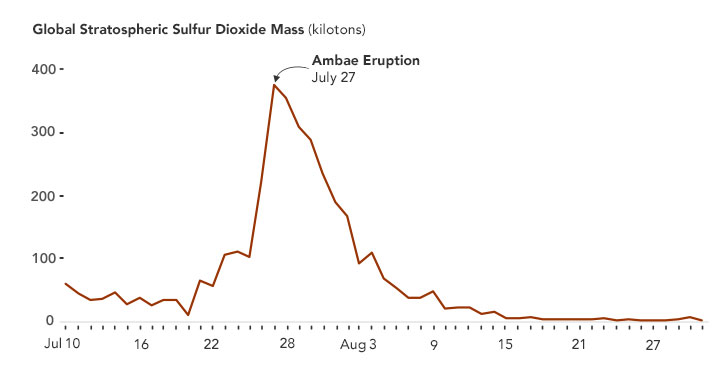

While Kilauea dominated headlines last year, the largest explosive eruption of 2018 occurred 5,600 kilometers (3,500 miles) to the southwest on Ambae, a volcanic island in Vanuatu. The Manaro Voui volcano spewed at least 400,000 tons of sulfur dioxide into the upper troposphere and stratosphere during its most active phase in July, and a total of 600,000 tons in 2018. That was three times the amount released from all combined eruptions in 2017.
The map above shows stratospheric sulfur dioxide concentrations on July 28, 2018, as detected by the Ozone Mapping Profiler Suite (OMPS) on the Suomi-NPP satellite. The volcano on Ambae (also known as Aoba) was near the peak of its sulfur emissions at the time. For perspective, emissions from Hawaii’s Kilauea and the Sierra Negra volcano in the Galapagos are shown on the same day. The plot below shows the July-August spike in emissions from Ambae.

“With the Kilauea and Galapagos volcanoes, you had continuous emissions of sulfur dioxide over time, but Ambae was more explosive,” said Simon Carn, professor of volcanology at Michigan Tech. “There was a giant pulse in late July, and then it dispersed.”
During a series of eruptions at Ambae in 2018, volcanic ash blackened the sky, buried crops, and destroyed homes. Acid rain turned the rainwater—the island’s main source of drinking water—cloudy and “metallic, like sour lemon juice,” said New Zealand volcanologist Brad Scott. Over the course of the year, the island’s population of 11,000 was forced to evacuate several times.
The OMPS instruments on the Suomi-NPP and NOAA-20 satellites contain downward-looking sensors, which can map volcanic clouds and measure sulfur dioxide (SO2) emissions by observing reflected ultraviolet light. SO2 and other gases (such as ozone) each have a spectral absorption signature, or unique fingerprint, that OMPS can measure and quantify.
“Once we know the SO2 amount, we put it on a map and monitor where that cloud moves,” said Nickolay Krotkov, a atmospheric scientist at NASA’s Goddard Space Flight Center. The maps, which are produced within three hours of a satellite overpass, are used by volcanic ash advisory centers to predict the movement of volcanic clouds and to reroute aircraft, if necessary.
At the peak of the Ambae eruption, a powerful burst of energy pushed gas and ash into the upper troposphere and stratosphere. The natural-color image above was acquired on July 27, 2018, by the the Visible Infrared Imaging Radiometer Suite (VIIRS) on Suomi NPP.
SO2 is short lived in the atmosphere, but once it penetrates the stratosphere, it can combine with water vapor to make sulfuric acid aerosols. Such particles can last much longer—weeks, months or even years—depending on the altitude and latitude of injection, Carn said.
In extreme cases, like the 1991 eruption of Mount Pinatubo, the tiny aerosol particles can scatter so much sunlight that they cool Earth’s surface below. “We think to have a measurable climate impact, the eruption needs to produce 5 to 10 million tons of SO2,” Carn said. The Ambae eruption was too small to cause such cooling.
“This wasn’t huge, it wasn’t Pinatubo,” Carn said. “But it was the biggest one of the year.”
NASA Earth Observatory images by Lauren Dauphin, using OMPS data from the Goddard Earth Sciences Data and Information Services Center (GES DISC), sulfur dioxide mass data courtesy of Simon Carn, and VIIRS data from the Suomi National Polar-orbiting Partnership. Story by Jenny Marder.